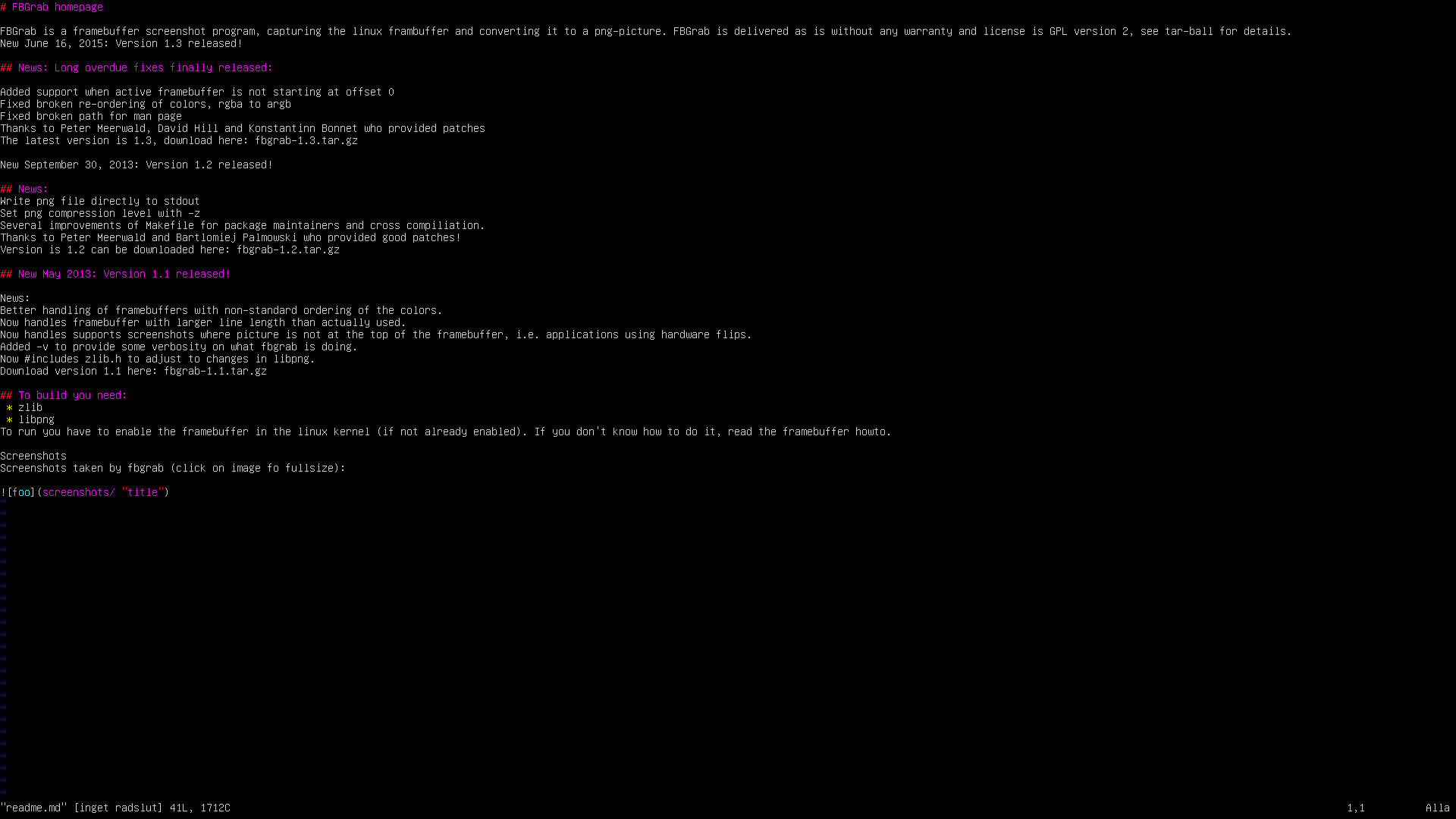FBGrab is a framebuffer screenshot program, capturing the linux frambuffer and converting it to a png-picture. FBGrab is delivered as is without any warranty and license is GPL version 2, see tar-ball for details.
fbgrab - takes screenshots using the framebuffer device
fbgrab [options] filename
fbgrab reads the framebuffer device (/dev/fb*) or a dump thereof and
saves a PNG image file. You can use it for making screenshots of of
virtually any application, from traditional test applications to your
X-windows desktop, as well as framebuffer applications.
-? print usage information.
-a ignore the alpha channel, to support pixel formats like BGR32.
-b bitdepth
the number of bits per pixel used, optional when reading from
device.
-c console
specifies which console (or virtual terminal - like other people
call this feature) to grab. Sometimes this changing is faster
then the framebuffer is refreshed (especially when grabbing
framebuffer apps). If so, you should use -C console ... This
waits some time before grabbing. You can't use -s in this case.
-d device
specifies which framebuffer device you want to read. If you do
not use this option, it takes the value from the FRAMEBUFFER
environment variable. If no FRAMEBUFFER environment variable is
given or if its value is NULL, then DEFAULT_FB is taken. (see
source code), which usually is /dev/fb0.
-f filename
Read from from file instead of device, requires that -w (width),
-h (height) and -b (bitdepth) are specified.
-h height
the height of the frambeuffer in pixels, optional when reading
from device.
-i turns off interlacing. If you do not want ADAM7 interlacing, you
should use the -i option.
-l line length, a.k.a. stride.
the length in pixels between the start of each row in the
framebuffer, which might be larger or equal to width. Optional
when reading from device.
-s seconds
specifies how many seconds to wait before grabbing. fbshot does
not lock console switching, so you can switch it while waiting,
if you cannot use -c requires normally that fbgrab is run as
root.
-v verbose
be verbose
-w width
the width of the frambeuffer in pixels, optional when reading
from device.
-z set png compression level 0 (fast) to 9 (best).
* Low-end bit depths, eg 1, 2, 4 & 8 bits.
* Companion program fbput that would display a picture in the fram‐
buffer.
* Better utilization of the PNG-lib, all formats are first converted to
32 bitdepth and then stored as PNG - hardly the right approach.
fbgrab fb.png
will take a framebuffer snapshot, or if you don't have fbgrab at your
machine, you can do
cp /dev/fb0 framebuffer.dump
and then
fbgrab -w 1024 -h 768 -b 16 -f framebuffer.dump fb.png
to convert it to a picture.
New in this release is the option to ignore the values in an by the driver incorrectly set alpha channel.
Thanks to @mrtims for providing the patch.
Stride support.
I. e. support for automatic detection and grab from framebuffers where line length differs from resolution.
Thanks to Frank Bauernoeppel.
Fix pixel format report
When fbgrab tells about the framebuffer pixel format, blue and green
are accidentally swapped in 'length' and 'msb_right' columns. Let's
order everything as RGB.
Thanks to Timo Ketola.
- Hosted on github
- Added support when active framebuffer is not starting at offset 0
- Fixed broken re-ordering of colors, rgba to argb
- Fixed broken path for man page
- Thanks to Peter Meerwald, David Hill and Konstantinn Bonnet who provided patches
- Write png file directly to stdout
- Set png compression level with -z
- Several improvements of Makefile for package maintainers and cross compiliation.
- Thanks to Peter Meerwald and Bartlomiej Palmowski who provided good patches!
- Better handling of framebuffers with non-standard ordering of the colors.
- Now handles framebuffer with larger line length than actually used.
- Now handles supports screenshots where picture is not at the top of the framebuffer, i.e. applications using hardware flips.
- Added -v to provide some verbosity on what fbgrab is doing.
- Now #includes zlib.h to adjust to changes in libpng.
- zlib
- libpng To run you have to enable the framebuffer in the linux kernel (if not already enabled). If you don't know how to do it, read the framebuffer howto.
Screenshots taken by fbgrab (click on image fo fullsize):
